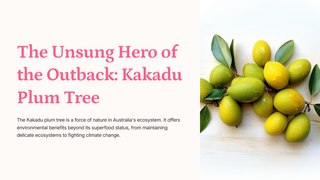Key Takeaways Table
| Fact | Details |
|---|---|
| ✅ Ecosystem Role | Keystone species in Northern Australia |
| ✅ Biodiversity Support | Provides habitat and food for various species |
| ✅ Soil Protection | Prevents erosion with extensive root system |
| ✅ Climate Adaptation | Thrives in harsh, changing conditions |
| ✅ Carbon Sequestration | Contributes to reducing atmospheric CO2 |

More Than Just a Superfood
From maintaining delicate ecosystems to fighting climate change, the Kakadu plum tree is truly a force of nature. Let's look at the environmental superpowers of this Aussie icon!
The Role of the Kakadu Plum Tree in Australia's Ecosystem
1. A Keystone Species
The Kakadu plum tree isn't just another pretty face in the Outback:
- ✅ Supports numerous animal species
- ✅ Contributes to the food web
- ✅ Maintains ecological balance
2. Biodiversity Hotspot
This tree is like a bustling apartment complex for wildlife:
- Provides nesting sites for birds
- Offers shelter for reptiles
- Attracts pollinators with its flowers
3. Indigenous Food Source
Not just for humans, but for native fauna too:
- Leaves support various insect species
- Seeds dispersed by birds, promoting regeneration
Sustainability and Community Impact
Kakadu plum harvesting supports Indigenous Australian communities.
Promotes sustainable land management practices in the Australian Outback.
Creates economic opportunities for Indigenous communities.

How Kakadu Plum Trees Protect Against Soil Erosion
1. Root System Extraordinaire
These trees are nature's own civil engineers:
- ✅ Deep, extensive root network
- ✅ Holds soil particles together
- ✅ Prevents topsoil loss during heavy rains
2. Water Management
Kakadu plum trees are masters of hydrology:
- Improve soil water retention
- Reduce runoff during storms
- Help maintain water table levels
3. Nutrient Cycling
These trees are nature's recycling plants:
- Leaf litter enriches soil
- Root systems bring deep nutrients to the surface
- Support beneficial soil microorganisms

Climate Adaptability and Benefits of Kakadu Plum Trees
1. Drought Resistance
These trees laugh in the face of dry spells:
- ✅ Efficient water use
- ✅ Ability to shed leaves to conserve water
- ✅ Deep roots access underground water sources
2. Fire Adaptation
In a land of bushfires, Kakadu plum trees stand strong:
- Thick bark protects against fire damage
- Quick regeneration after fires
- Act as natural firebreaks in some landscapes
3. Carbon Sequestration
Kakadu plum trees are unsung heroes in the fight against climate change:
- ✅ Absorb CO2 from the atmosphere
- ✅ Store carbon in wood and roots
- ✅ Contribute to reducing greenhouse gas levels
Premium KAKADU PLUM Powder Wild Australian Superfood
This native Australian fruit boasts the highest recorded levels of Vitamin C, containing over 100 times the amount found in oranges!
View NowGUT OPTIMAX Health Superfood Powder 65g - Slippery Elm, Aloe Vera.
Gut Optimax is a powerful, food-based prebiotic blend formulated by our naturopath to help you achieve optimal gut health.
View NowThe Ripple Effect: Broader Environmental Impacts
-
Microclimate Regulation:
- Provide shade, reducing ground temperatures
- Act as windbreaks, protecting other vegetation
-
Soil Improvement:
- Nitrogen fixation improves soil fertility
- Leaf litter increases organic matter in soil
-
Water Cycle Support:
- Contribute to local humidity through transpiration
- May influence local rainfall patterns
-
Ecosystem Resilience:
- Help ecosystems recover from extreme weather events
- Contribute to overall landscape stability

Q&A: Your Questions About Kakadu Plum Trees and the Environment
Q: Can Kakadu plum trees help combat desertification?
A: Yes! Their ability to prevent soil erosion and retain water makes them valuable in fighting desertification.
Q: Do Kakadu plum trees have any negative environmental impacts?
A: When growing in their native range, Kakadu plum trees are well-balanced within their ecosystem. However, like any species introduced to new areas, they could potentially become invasive if not managed properly.
Q: How do Kakadu plum trees compare to other trees in terms of carbon sequestration?
A: While specific data is limited, their ability to thrive in harsh conditions and their long lifespan make them effective carbon sinks.
Q: Can Kakadu plum trees be used in reforestation projects?
A: Absolutely! They're excellent candidates for reforestation in appropriate climates, particularly in areas prone to soil erosion or desertification.
How You Can Support Kakadu Plum Tree Conservation
- ✅ Choose Sustainable: Buy Kakadu plum products from sources that support conservation
- ✅ Spread Awareness: Share information about the environmental benefits of these trees
- ✅ Support Research: Look for organizations studying and protecting native Australian flora
- ✅ Plant Native: If you live in a suitable climate, consider planting native species like Kakadu plum
- ✅ Reduce Your Carbon Footprint: Every bit helps in supporting the work these trees do!
The Tree That Keeps on Giving
The Kakadu plum tree isn't just a superfood powerhouse – it's a superstar of the plant world, playing a crucial role in maintaining the health of Northern Australia's ecosystems.
From supporting biodiversity and protecting soil to adapting to harsh climates and combating climate change, these trees are true environmental heroes.
As a naturopath, I'm always amazed by how nature provides solutions to both our health and environmental challenges. The Kakadu plum tree is a perfect example of this synergy – while it offers incredible nutritional benefits to us, it's simultaneously nurturing and protecting its environment.
By appreciating and protecting Kakadu plum trees, we're not just preserving a valuable food source or a piece of Australia's natural heritage.
We're supporting a key player in the fight against some of our planet's most pressing environmental issues. Now that's what I call a true superfood – super for us, and super for the Earth!
About the Author: Frances Simmons. As a qualified naturopath at D2E Naturopathy, I'm passionate about the interconnectedness of human health and environmental wellbeing. My expertise in nutritional medicine, combined with a deep appreciation for Australia's native flora, drives my commitment to promoting sustainable practices that benefit both people and planet.










